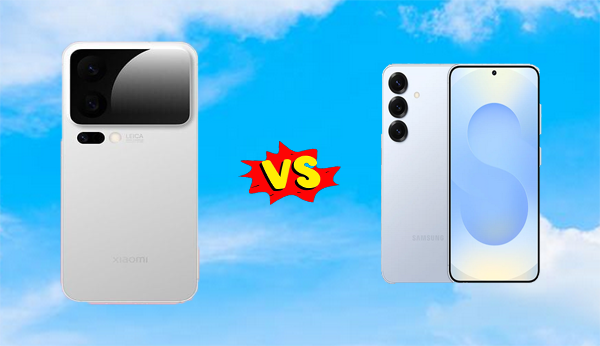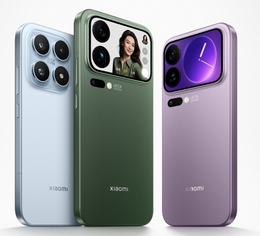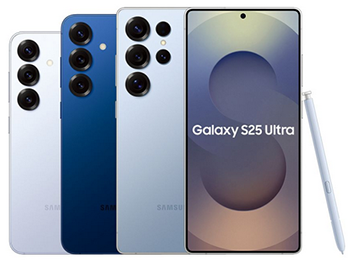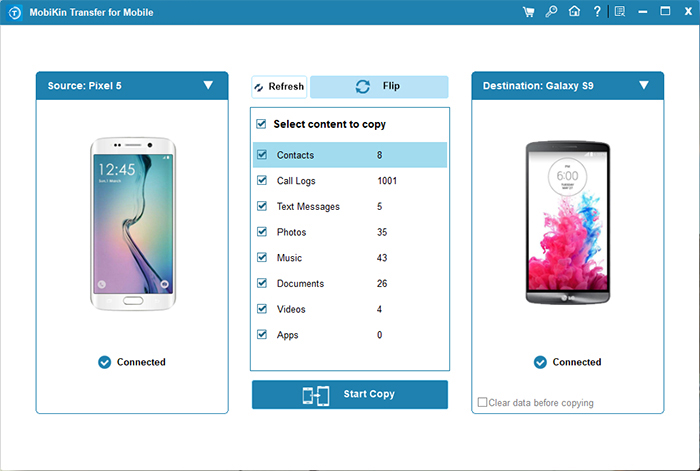Who Is Better, Samsung or Xiaomi? A Comparison of the Latest Model's Functions
When it comes to choosing a new smartphone, many users are eager to compare the two brands and latest models across key factors before buying a new smartphone. From the latest flagship features to better user experience, understanding the differences between Xiaomi vs. Samsung can make a significant impact on your decision. So, "Is Xiaomi beating Samsung?".
This article provides a comprehensive Xiaomi vs Samsung comparison, covering design, performance, cameras, battery life, and more, helping you choose the device that best fits your needs.

- Part 1: Xiaomi vs Samsung: Basic Comparison
- Part 2: Xiaomi 17 vs Samsung Galaxy S25
- Part 3: Xiaomi 17 Pro vs Samsung S25 Galaxy Plus
- Part 4: Xiaomi 17 Pro Max vs Samsung S25 Ultra
- Part 5: Xiaomi 15 Ultra vs. Samsung Galaxy S25 Ultra
- Who Is Better, Samsung or Xiaomi? Expert Advice
- Extra: How to Transfer Data to a New Xiaomi/Samsung Phone
Part 1: Xiaomi vs Samsung: Basic Comparison
Recent Xiaomi and Samsung series and models come with competitive features that appeal to different types of users. Both brands offer advancements in camera performance, durability, battery life, and software updates, making the Xiaomi vs Samsung debate more relevant than ever. The table below highlights the key differences and similarities between the two:
|
Feature
|
Xiaomi
|
Samsung
|
|
Xiaomi vs Samsung Camera
|
Offers high-megapixel cameras (up to 200MP on some models) at affordable prices; strong low-light photography in flagship phones. |
Delivers consistently balanced and color-accurate photos; Samsung's flagship models excel in video recording and night mode. |
|
Xiaomi vs Samsung Durability
|
Decent build quality; mid-range devices may use plastic backs; flagship models come with Gorilla Glass protection but fewer IP ratings. |
Generally more durable; higher-end models often feature IP68 water and dust resistance; stronger reputation for long-term reliability. |
|
Performance
|
Powerful hardware, often with top-tier Snapdragon or MediaTek chips; MIUI may have ads in budget devices. |
Smooth performance with optimized One UI; stronger software support and updates. |
|
Battery Life
|
Larger batteries and faster charging speeds (up to 120W on some models). |
Good battery optimization; charging speeds are slower compared to Xiaomi. |
|
Software Updates
|
Provides frequent updates but a shorter support timeline than Samsung. |
Offers longer Android OS and security update commitments. |
|
Price & Value
|
Known for competitive pricing; more features for the money, especially in mid-range phones. |
Higher price tag but stronger brand reputation, customer support, and resale value. |
You Might Also Like: Compare Samsung Galaxy S25 Edge vs iPhone Air [In-depth Analysis]
Part 2: Xiaomi 17 vs Samsung Galaxy S25
Here's a table summarizing the basic (non-Pro/Plus, etc) versions of the latest phone of Xiaomi 17 vs Samsung Galaxy S25 models, based on the latest leaks & confirmed specs:
Xiaomi 17 (Base Model):
The latest Xiaomi 17 features a ~6.3-inch 2K OLED display with smooth 120Hz refresh. It is powered by the Snapdragon 8 Elite Gen 5 with ~12GB RAM and 256GB storage. The phone packs triple 50MP rear cameras and a ~32MP front shooter. A massive ~7,000mAh battery with up to 100W fast charging and HyperOS 3 based on Android 16 make it stand out.

Samsung Galaxy S25 (Base Model):
The Samsung Galaxy S25 offers a 6.2-inch FHD+ Dynamic AMOLED 2X display with 120Hz refresh. It runs on a Snapdragon 8 Elite chipset with up to 512GB storage options. The camera setup includes a 50MP main, 12MP ultra-wide, 10MP telephoto, and a 12MP selfie camera. A ~4,000mAh battery with 25W wired and 15W wireless charging complements its premium IP68 durable build and One UI 7 on Android 16.

People Also Like: Smart Switch vs Google Backup: A Complete & Unbiased Comparison
Part 3: Xiaomi 17 Pro vs Samsung S25 Galaxy Plus
The latest Xiaomi 17 Pro and the Samsung S25 Galaxy Plus are two flagship models that bring powerful performance, premium design, and advanced camera systems to the table. The following will talk about the key info about Xiaomi 17 Pro vs Samsung S25 Galaxy Plus, highlighting their main similarities and differences.
|
Feature
|
Xiaomi 17 Pro
|
Samsung Galaxy S25 Plus
|
|
Processor/Chipset
|
Snapdragon 8 Elite Gen 5 |
Snapdragon 8 Elite (3 nm) |
|
Display
|
~6.73-inch 2K OLED, with rear "Magic Back Screen" for notifications and extra functions |
6.7-inch Dynamic LTPO AMOLED 2X, 1440×3120, 120 Hz refresh rate |
|
Rear Camera(s)
|
Triple 50 MP setup: wide (main), ultra-wide, telephoto (5× optical zoom), Leica collaboration |
Triple camera: 50 MP wide (main) + 12 MP ultra-wide + 10 MP telephoto (3× optical zoom) |
|
Front Camera
|
~32 MP |
12 MP |
|
Battery & Charging
|
~6,100 mAh battery; expected fast and wireless charging |
4,900 mAh; 45 W wired, 15 W wireless, reverse wireless charging (Your old Galaxy not charging?) |
|
Durability/Build & Extras
|
Premium design with "Magic Back Screen"; likely IP rating and Gorilla Glass |
Gorilla Glass Victus 2 front & back, IP68 water & dust resistance, Armor aluminum frame |
More to Explore: How to Fix Xiaomi/Mi Cloud Not Working? 9 Fixes & 1 Alternative
Part 4: Xiaomi 17 Pro Max vs Samsung S25 Ultra
The Xiaomi 17 Pro Max and Samsung Galaxy S25 Ultra are also two flagship smartphones offering cutting-edge performance, advanced cameras, and premium features. The following will highlight the key info about Xiaomi 17 Pro Max vs Samsung S25 Ultra in a detailed comparison table:
|
Feature
|
Xiaomi 17 Pro Max
|
Samsung Galaxy S25 Ultra
|
|
Display
|
~6.8-inch 2K OLED LTPO; includes "Magic Back Screen" around camera island |
6.9-inch Dynamic LTPO AMOLED 2X; 120Hz refresh; Gorilla Armor 2 protection |
|
Processor/Chipset
|
Snapdragon 8 Elite Gen 5 |
Snapdragon 8 Elite (3nm) |
|
Rear Cameras
|
Triple 50 MP setup with telephoto zoom (5× optical), Leica collaboration |
Quad cameras: 200 MP main, 50 MP ultra-wide, 50 MP periscope telephoto (5×), 10 MP telephoto (3×) |
|
Front Camera
|
50 MP |
12 MP |
|
Battery & Charging
|
~7,500 mAh battery; fast charging up to ~100W; wireless charging supported |
5,000 mAh battery; 45W wired charging; 15W wireless charging; reverse wireless |
|
Durability & Extras
|
"Magic Back Screen"; premium build; expected IP rating; large screen real estate |
IP68 rating; titanium frame; strong build materials; stereo speakers and high brightness display |
Part 5: Xiaomi 15 Ultra vs. Samsung Galaxy S25 Ultra
Xiaomi 15 Ultra:
The Xiaomi 15 Ultra features a 6.73-inch LTPO AMOLED display with 3200×1440 resolution and peak brightness of 3200 nits. It is powered by the Snapdragon 8 Elite chipset and offers up to 1TB of UFS 4.1 storage. The camera system includes a versatile Leica-branded setup: 50MP main, 50MP ultrawide, and 50MP telephoto lenses. The device supports 90W wired charging and 50W wireless charging for fast power top-ups.
Samsung Galaxy S25 Ultra:
The Samsung Galaxy S25 Ultra comes with a 6.9-inch LTPO AMOLED display at 3120×1440 resolution and peak brightness of 2600 nits. It runs on the Snapdragon 8 Elite processor and supports up to 1TB of storage. Its camera setup features a 200MP main sensor, 50MP ultrawide, and two telephoto lenses (10MP 3× and 50MP 5×). The phone supports 45W wired charging and 15W wireless charging, along with other premium features.
Who Is Better, Samsung or Xiaomi? Expert Advice
Which is better, Samsung or Xiaomi? Here are some factors to consider:
- Xiaomi 15 Ultra: Snapdragon 8 Gen 3 and 200MP Leica camera for flagship performance at a lower price.
- Xiaomi 17: Large battery (7,000mAh) and fast 90W charging.
- Xiaomi 17 Pro: Leica triple camera and 6.3" 2K OLED display for premium photography.
- Xiaomi 17 Pro Max: 6.8" 2K OLED and advanced Leica cameras for top-tier photography.
- Samsung Galaxy S25: Balanced performance and value with Snapdragon 8 Elite and versatile cameras.
- Samsung Galaxy S25 Plus: Larger 6.8" AMOLED and better battery for media and multitasking.
- Samsung Galaxy S25 Ultra: 200MP camera, S Pen support, and premium build for power users and professionals.
Summary: Choose Xiaomi for fast charging, big batteries (What if your phone drains faster?), and advanced cameras; choose Samsung for refined software, premium build, and extra features.
Extra: How to Transfer Data to a New Xiaomi/Samsung Phone
When switching to a new Xiaomi 17 or Samsung S25 model, don't forget to transfer data from your old phone, whether it's Android or iPhone. MobiKin Transfer for Mobile is a professional and worry-free tool designed to make this process seamless. With its user-friendly interface and fast transfer speed, all your contacts, messages, photos, and apps can move safely to your new device without any hassle. Here's how to use it:
- Install and launch MobiKin Transfer for Mobile on your computer.
- Connect both your old phone and new device via USB.
- Follow the prompts to get your devices virtually connected.
- Check the source (old phone) and destination (new phone) (Tap Flip when they are wrongly placed).
- Choose the data you want to transfer (contacts, messages, photos, etc.).
- Click "Start Copy" and wait until the process completes.

Video Guide:
Related Articles:
How to Hard Reset Xiaomi/Redmi/Mi with/without Computer? 6 Options
6 Verified Methods to Fix Bricked Samsung Phone [Latest Info]
10 Best Samsung Data Recovery Software/Apps [2025 Latest]
5 Quick Ways to Transfer WhatsApp from Samsung to Xiaomi/Mi/Redmi



